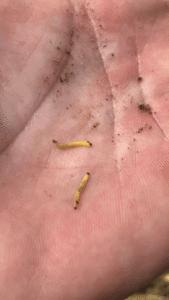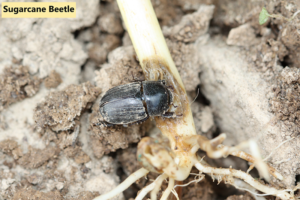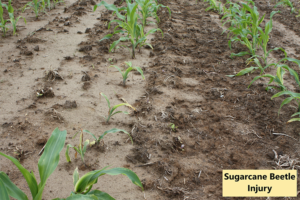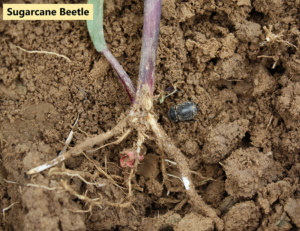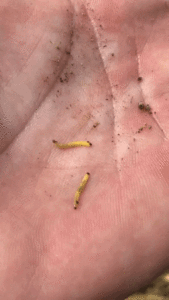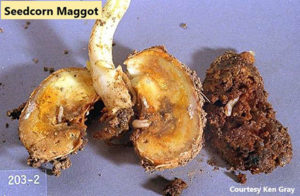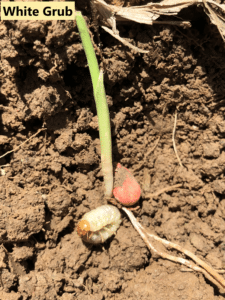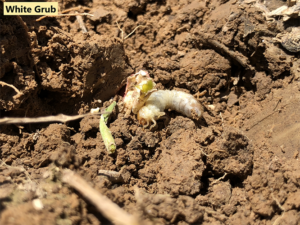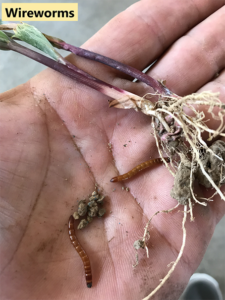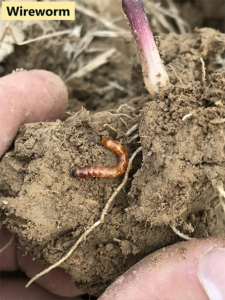Management options
Relative Efficacy of Selected Insecticide Seed Treatments on Seed and Seedling Insect Pests
| Trade Names* | Active Ingredients and Rates* | Billbugs | White grubs | Wire-worms | Seedcorn maggot | Cutworms | Sugarcane beetle** | Stink bugs | Chinch bugs | Southern corn rootworm | Western corn rootworm |
|---|---|---|---|---|---|---|---|---|---|---|---|
| Poncho 250, Acceleron, NipsIt Inside | clothianidin, 0.25 mg ai/kernel | NL | F | G | E | P - F | F | F | G | E | P, NL |
| Poncho 500, Acceleron with Poncho Votivo, NipsIt Inside | clothianidin, 0.50 mg ai/kernel | F | E | G | E | P - F | G | F - G | G - E | E | P |
| Poncho 1250, Acceleron with Poncho Votivo 1250, PPST + Poncho 1250/Votivo, NipsIt Inside | clothianidin, 1.25 mg ai/kernel | G | E | E | E | F - G | G | G | E | E | G |
| Cruiser Maxx 250, PPST | thiamethoxam, 0.25 mg ai/kernel | NL | F | F-G | E | P | P | P | F | G - E, NL | P, NL |
| Cruiser Maxx Corn 500, Avicta Complete Corn 500 | thiamethoxam, 0.50 mg ai/kernel | NL | G | G | E | P | F? | F | F | E | P, NL |
| Cruiser Maxx Corn 1250, Avicta Complete Corn 1250 | thiamethoxam, 1.25 mg ai/kernel | G | E | E | E | F | F? | G | G | E | P |
| PPST 250 plus Lumivia | thiamethoxam, 0.25 mg ai/kernel; chlorantraniliprole, 0.25 mg ai/kernel | E | G? | G? | E | G? | P | P | F | G - E, NL | NL |
| Gaucho 600, Dynashield, Imidacloprid 5, Nitro Shield, Senator 600, etc. | imidacloprid, 0.60 mg ai/kernel (mid-labeled rate) | P, NL | G | G | E | P, NL | P, NL | P, NL | F | G, NL | P, NL |
| Latitude | imidacloprid, 3.5 oz/100 lb seed | P, NL | F, NL | G | G | P, NL | P, NL | P, NL | F, NL | G, NL | P, NL |
| Concur | imidacloprid, 1.5 oz/42 lb seed | P, NL | F | G | G | P, NL | P, NL | P, NL | F, NL | G, NL | P, NL |
E = excellent, G = good, F = fair, P = poor or no activity, ? = insufficient data to provide confident ranking, NL = pest not listed on label. Some ratings are based on incomplete data and are only meant to provide a general guideline of relative efficacy to the best knowledge of the author. Parts of this table are courtesy of Auburn University‘s corn insect, disease, nematode, and weed control recommendations for 2017
* Formulated product may also include fungicidal and/or nematicidal ingredients that are not listed.
** Efficacy of seed treatments on sugarcane beetle is dependent upon the timing of infestation. Expect less control if infestations occur several weeks after emergence.
Examples of At-Planting Treatments for Seed and Seedling Insect Pests
| Insecticide (Trade Names) | Rates | Common Pests Controlled or Suppressed |
|---|---|---|
| terbufos (Counter 20G)* | 5 - 6 oz/1000 row ft | Seedcorn maggot, Southern corn rootworm, Wireworms, White grubs |
| cyfluthrin, tebupirimphos (Aztec 2.1G)* | 6.7 oz/1000 row ft | Seedcorn maggots, Southern corn rootworm, Wireworms, White grubs, Cutworms |
| tefluthrin (Force 3G) | 4 - 5 oz/1000 row ft | Seedcorn maggots, Southern corn rootworm, Wireworms, White grubs, Cutworms |
| bifenthrin (Brigade 2E, Discipline 2E, Fanfare 2E)** | 0.15 - 0.3 oz/1000 row ft | Seedcorn maggots, Southern corn rootworm, Wireworms, White grubs |
| bifenthrin (Capture LFR 1.5) | 0.2 - 0.78 oz/1000 row ft | Seedcorn maggots, Southern corn rootworm, Wireworms, White grubs, Cutworms, Sugarcane beetle |
| λ-cyhalothrin (Ballista LFC 1) | 0.66 oz/1000 row ft | Seedcorn maggots, Southern corn rootworm, Wireworms, White grubs, Cutworms |
See the insecticide label for specific use instructions.
* Caution: When using organophosphate insecticides such as Aztec or Counter with herbicides such as Accent, Callisto, Capreno, Halex GT, Steadfast, Option or Resolve, the possibility for plant injury exists. See herbicide label for restrictions.
** Many other pyrethroid insecticides are labeled for at-planting control of cutworms and some other pests. These include Asana XL, Baythroid XL, Declare, Mustang Max and Pounce. Please see their labels for specific use instructions.
- No-till or reduced-tillage farming generally increases the likelihood of soil insect pests.
- Consider using the higher-labeled rates of an insecticide seed treatment or an in-furrow applied insecticide (see tables above) when you have a known soil insect problem, planting in a field that was fallow, pasture or sod the previous season, or a cover crop was used and not terminated at least 3-4 weeks before planting.
- Economic damage from southern corn rootworm, seedcorn maggot, and white grubs is uncommon because most seed corn companies apply an insecticide seed treatment.
- Higher insecticide seed treatment rates or the use of in-furrow insecticides may be needed if wireworms, western corn rootworms, or sugarcane beetles are present in significant numbers.
